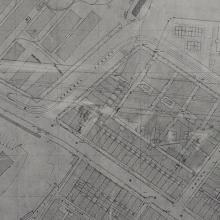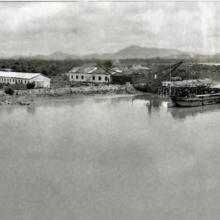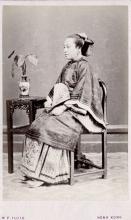After contacting Theodor A.R. Strauss, 1988-1993 secretary of Nederlandse Reünisten Vereniging China (NRCV, Dutch Reunists Association China) about a detail I found about works performed for Hong Kong Kai Tak airport in 1927 by Netherlands Harbour Works Co., he brought me in contact with two sons of an engineer who worked for the company in the 1930s to 1960s. The eldest son of Jan and Mieke Wesselingh, Hans (J.A.) Wesselingh, had written a document about the story of their parents in China and the younger son Rob Wesselingh sent me additional information via e-mail. With their kind permission, part of their photos and story are shared here.
Jan Wesselingh (1904-1971) was born as the third child of a farmer’s family in the Netherlands. He was the only child to study, at the Technical University of Applied Science in Delft (Technische Hoogeschool Delft). Nowadays it is still a Technical University of fame. Due to the Great Depression, which started in 1929, just after Jan’s graduation it was very difficult to find a job. However, Jan was adventurous and a little cheeky and via his professor who supervised his graduation, he was offered a job to work in China for Nederlandsche Maatschappij voor Havenwerken (NMH, Netherlands Harbour Works Co.), ca. 1932. Travel by boat took over a month and was rather expensive, so his first contract lasted for four years, after which he received three months of leave. He worked along the China coast, at dredging and harbour building projects.
In 1936, during his leave in the Netherlands, he met his future wife, Mieke Teepe (1912-2002). Their romance was not an easy one, Mieke’s father had to be persuaded by other family members to let his daughter live in Ireland for three months, where Jan was doing a job for NMH. This gave them a chance to see if they were fit for one another. The outcome was positive, and they married in October 1936 (photo).
Directly after their wedding, they travelled to Berlin and left for an 11-day train journey with the Trans-Siberia Express. Via Moscow and Lake Baikal, which they found very beautiful, they travelled through the Soviet Union and Japanese occupied Manchuria, to reach Beijing (Peking at the time). According to Mieke’s diary it was one of the most beautiful cities she knew. Few multi-storey buildings and very characteristic architecture. Foreigners had their own community in Beijing, a community which changed all the time. New arrivals were welcomed heartily.
After a few days they travelled by train to Shanghai, a poor and dirty harbour city in their view. Then by boat to Hong Kong, fifteen hundred kilometres south. Hong Kong, an English colony at the time, gave them a cosmopolitan and well organised impression. China impoverished greatly after the Western imposed favourable tax treatment of companies in the foreign concessions in China, after the 1839-1860 Opium Wars. It explains what they experienced: a great many foreigners, an abundance of goods for sale and many recreational opportunities. A major difference in comparison to the impoverished Chinese cities they had seen.
The final part of the journey was only two hundred kilometres, to Guangzhou (Canton at the time). The city gave them a poor, dirty impression and seemed to be not without danger. Jan Wesselingh was project leader in a naval harbour construction project, in Huangpu District, Guangzhou (at the time Whampoa, south-east of Guangzhou). The 1938 photo shows how rural Huangpu District still was at the time.
Hans Wesselingh was born in Guangzhou (Canton) in 1937. One year later, the family fled after the Japanese bombarded the city. They left on an English gunboat, fearful times!
The photo of the eight figurines represents seven wise men and a woman, Hans Wesselingh was once explained. Supposedly, the figurines were given to his parents for the occasion of his birth, by their housekeeper, Mrs Ah-Lin, when they were living in Huangpu District. She continued to work as their housekeeper when they were living in Hong Kong after the 2nd World war.
After the 1938 evacuation, Jan Wesselingh found employment for the dredger fleet, which managed to escape from Guangzhou as well. There was work in Tasmania, where the port of Devonport had to be dredged and enlarged. Rob Wesselingh was born there in 1940. In 1942 the project was finished and new work for the dredger fleet had to be found. In Iran (Persia at the time), a new project was contracted. On the way to Iran, Jan Wesselingh arrived in Jakarta (Batavia at the time), where he was enlisted as a reserve air force officer, after Japan had declared war on the Netherlands East Indies. When the Dutch capitulated, Jan Wesselingh was imprisoned in a Japanese camp. He survived and returned to Tasmania.
The family returned to the Netherlands and early 1947 they left for Hong Kong, where Jan continued to work for MVH to coordinate Far East activities. In Hong Kong there were large projects such as typhoon shelters in Causeway Bay and Aberdeen and another project was in Macau.
In Rob Wesselingh’s recollection, the activities in Hong Kong were preparations for the large project of the new Kai Tak airport, which was going to be built on a dam in the harbour. In the end a French company managed to ‘capture’ the assignment, when they were forced out of Vietnam (French Indochina at the time) and offered the project at a price far below market rates.
The 1953 photo of a dredger in Hong Kong gives an impression of the type of work Jan performed. In the 1950s, Jan Wesselingh was the head of the Far East department at NMH, the only large contractor which had dared to stay in Hong Kong after the Communist revolution in China. He supervised some 2,000 people at the time, most of them Chinese workers.
Rob Wesselingh went to the Netherlands in 1950 and after education and military service, he was sent by KJCPL (the successor of Java-China Japan Line, where Charles Gesner van der Voort’s friends Dorone van den Brandeler, Frikkie Wiersum and Harry de Haan worked in Shanghai) to Hong Kong, where he married in 1965 and where their three children were born.
Courtesy Wesselingh family archives
<a href="https://old.gwulo.com/%3Ca%20href%3D"http://docplayer.nl/10021344-Reis-naar-china-door-hans-j-a-wesselingh-oudste-zoon-van-jan-en-mieke-wesselingh.html">http://docplayer.nl/10021344-Reis-naar-china-door-hans-j-a-wesselingh-ou..." rel="noreferrer nofollow">docplayer.nl/10021344-Reis-naar-china-door-hans-j-a-wesse...</a>





Comments
Wesselingh family archives
Dear reader,
New text was added to the photo.
Kind regards,
Pieter